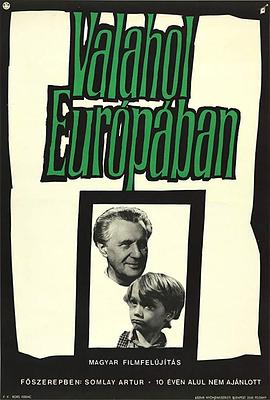 snm3u8
snm3u8
 欧洲的某个地方的剧情简介 · · · · · ·
欧洲的某个地方的剧情简介 · · · · · ·
Somewhere in the remote region, the war ends. In the midst of ruined cities and houses in the streets, in rural hamlets, everywhere where people still live, are children who have lost their homes and parents. Abandoned, hungry, and in rags, defenseless and humiliated, they wander through the world. Hunger drives them. Little streams of orphans merge into a river which rushes forward and submerges everything in its path. The children do not know any feeling; they know only the world of their enemies. They fight, steal, struggle for a mouthful of food, and violence is merely a means to get it. A gang led by Cahoun finds a refuge in an abandoned castle and encounters an old composer who has voluntarily retired into solitude from a world of hatred, treason, and crime. How can they find a common ground, how can they become mutual friends The castle becomes their hiding place but possibly it will also be their first home which they may organize and must defend. But even for this, the price will be very high. To this simple story, the journalist, writer, poet, scriptwriter, movie director, and film theoretician Béla Balázs applied many years of experience. He and the director Géza Radványi created a work which opened a new postwar chapter in Hungarian film. Surprisingly, this film has not lost any of its impact over the years, especially on a profound philosophical level. That is to say, it is not merely a movie about war; it is not important in what location and in what period of time it takes place. It is a story outside of time about the joyless fate of children who pay dearly for the cruel war games of adults. At the time it was premiered, the movie was enthusiastically received by the critics. The main roles were taken by streetwise boys of a children's group who created their roles improvisationally in close contact with a few professional actors, and in the children's acting their own fresh experience of war's turmoil appears to be reflected. At the same time, their performance fits admirably into the mosaic of a very complex movie language. Balázs's influence revealed itself, above all, in the introductory sequences an air raid on an amusement park, seen in a montage of dramatic situations evoking the last spasms of war, where, undoubtedly, we discern the influence of classical Soviet cinematography. Shooting, the boy's escape, the locomotive's wheels, the shadows of soldiers with submachine guns, the sound of a whistle—the images are linked together in abrupt sequences in which varying shots and expressive sharp sounds are emphasized. A perfectly planned screenplay avoided all elements of sentimentality, time-worn stereotypes of wronged children, romanticism and cheap simplification. The authors succeeded in bridging the perilous dramatic abyss of the metamorphosis of a children's community. Their telling of the story (the scene of pillaging, the assault on the castle, etc) independently introduced some neorealist elements which, at that time, were being propagated in Italy by De Sica, Rossellini, and other film artists. The rebukes of contemporary critics, who called attention to formalism for its own sake have been forgotten. The masterly art of cameraman Barnabás Hegyi gives vitality to the poetic images. His angle shots of the children, his composition of scenes in the castle interior, are a living document of the times, and underline the atmosphere and the characters of the protagonists. The success of the picture was also enhanced by the musical art of composer Dénes Buday who, in tense situations, inserted the theme of the Marseilaise into the movie's structure, as a motive of community unification, as an expression of friendship and the possibility of understanding. Valahol Europaban is the first significant postwar Hungarian film. It originated in a relaxed atmosphere, replete with joy and euphoria, and it includes these elements in order to demonstrate the strength of humanism, tolerance, and friendship. It represents a general condemnation of war anywhere in the world, in any form.——由小草影视(www.99moyu.cc)全网络收集并分享发布,仅供用于学习和交流。

 欧洲的某个地方QA问答 · · · · · ·
欧洲的某个地方QA问答 · · · · · ·
Q:《欧洲的某个地方》1、请问影片是什么时候上映的?这部电影的评价怎样?
A: 这部影片的上映时间是:1948-11-19(1948)首先,让我来给大家科普一下这部电影的背景。据我调查,这部影片是由一线导演执导的,他之前的作品口碑都很不错,这次也不负众望,再次为观众呈现出了一部佳作。这部电影在上映后,不仅口碑爆棚,还获得了多个奖项的认可。根据我从豆瓣上找到的数据显示,该电影的评分高达9.0分,绝对是一部超高分佳片!这可是相当不易的啊!。
Q:《欧洲的某个地方》 2、这部剧中的台词,你怎么看??
A: 要说这部剧的台词怎样看,我得从多个角度给你分析分析。首先,我们得看剧的类型和主题,毕竟不同的剧风和故事背景会影响台词的风格和表达方式嘛。其次,咱们还得看演员们的演技水平,毕竟演员把台词诠释得如何,也是很重要的一点。最后,还得考虑剧本的质量,好的剧本能给观众带来更多的共鸣和思考。欧洲的某个地方。是由Radványi,Géza执导,Artúr,Somlay,Miklós,Gábor,Zsuzsa,Bánki主演的剧情剧!该剧于1948-11-19在腾讯、爱奇艺、小草影视、优酷、等平台同步播出。
Q:《欧洲的某个地方》3、这部电影最吸引你的元素是什么??
A:《欧洲的某个地方》首先,这部电影的特效真是没话说。你知道嘛,所有的特效都是由顶级的视觉团队打造的。他们使用了最新的技术,让每一个场景都如梦似幻。还有那些奇幻的世界,简直就是一场视觉盛宴!数据显示,这部电影的特效团队使用了超过1000台电脑来渲染影片,每一帧都是精心制作的艺术品。其次,我要说说电影的摄影。导演真是太厉害了,他的镜头运用简直就是神级!记得有一场戏,主角在高楼顶上与反派大战,阳光透过云层洒在他们身上,那个画面简直就是诗意的绝美插图!眼前的一切都是那么真实,那么美丽,就好像我亲眼目睹了这一切。这样的摄影技巧,简直就是艺术的巅峰啊!最后,我想说一下电影的音效。这部电影的音效团队真的是功不可没!每一场戏的音效都让人血脉贲张。
Q:《欧洲的某个地方》4、哪个网站可以免费看正版影片?
A:《欧洲的某个地方》目前只有腾讯视频、爱奇艺、优酷、小草影视等平台同步播出。你也可以在小草影视网上观看。小草影视-最新热门电影免费在线观看
Q: 5、哪个网站可以免费看影片《欧洲的某个地方》??
A:不用VIP免费高清在线观看的网站地址:www.99moyu.cc/detail123s/231245.html
 欧洲的某个地方的短评 · · · · · ·
欧洲的某个地方的短评 · · · · · ·

《欧洲的某个地方》来自【爱奇艺视频】的网友短评
2024-03-08 10:38

《欧洲的某个地方》来自【小草影视】的网友短评
2024-03-08 10:38

《欧洲的某个地方》来自【豆瓣电影】的网友短评
2024-03-08 10:38

《欧洲的某个地方》来自【腾讯视频】的网友评论
2024-03-08 10:38